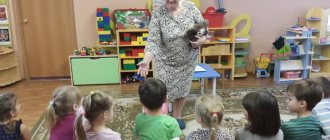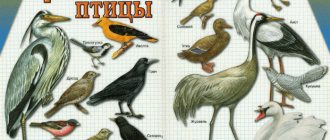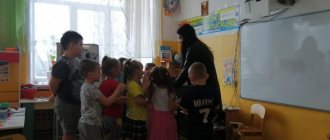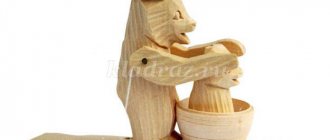LESSON SUMMARY ON SPEECH DEVELOPMENT “Birds.” lesson plan on speech development on the topic
LESSON SUMMARY ON SPEECH DEVELOPMENT
"Birds."
Goals: to develop children’s dialogical speech, to develop global reading, to encourage participation in conversation, to teach how to answer questions, to compose a descriptive story about an object; activate adjectives in children’s speech; learn to select accurate comparisons, learn to pronounce words and phrases with different voice strengths; cultivate a caring attitude towards birds. Preliminary work. Watching city birds while walking; looking at illustrations of birds; reading stories about the behavior of urban birds, memorizing poems, riddles, sayings about birds. Equipment: pictures depicting migratory and wintering birds according to the number of children, name plates, a picture of the sun, intonation mnemonic squares (3 pcs.), audio recording of bird voices Progress of the lesson Children sit on the carpet and pretend to sleep. The teacher enters. The teacher (P.). Good morning! The birds began to sing. Good people, get out of bed! All the darkness hides in the corners, the Sun rises and goes about its business. Children stand in a circle. The teacher invites the children to say to each other “Good morning!” P. How should you say this phrase? (Joyfully, smiling, cheerfully.) Why? It is advisable that all children say this phrase.P. Look at the tree, the birds have flown. The teacher and children name migratory and wintering birds. Physical education minute.
Little birds
Small birds
They fly through the forest,
They sing songs (we wave our arms like wings)
A violent wind blew in (hands up, swaying from side to side)
I wanted to take away the birds.
The birds hid in a hollow (we squat down, cover our heads with our hands)
No one will touch them there.
The teacher gives the children pictures depicting migratory and wintering birds, invites the children to look at them and complete the task. Place pictures depicting wintering birds on the carpet, and pictures with migratory birds place them on the table. The teacher offers a riddle: A person known to everyone, She is a local screamer, She sees a dark cloud - She flies up to a green spruce. And he looks as if from a throne. Who is she? (Crow.) Children show signs. The children find it on the carpet and note that the crow is the largest among the city birds. The teacher reads the second riddle: The bird is small, has legs, but cannot walk. Wants to take a step - It turns out to be a jump. Who is this? (Sparrow.) Children show signs.P. Look and tell me what kind of sparrow it is? (Small, nimble, brown...)(description according to the diagram) • What will we affectionately call him? (Little sparrow, little sparrow...) • Now compare the crow and the sparrow. • What are the sparrow's legs like? (Small paws, tiny.) • What kind of paws does a crow have? (Big, huge paws.) • What kind of head does a sparrow have? (Small head, tiny.) • And the crow? (The big head is the head.) • What kind of beak does the sparrow have? (Small beak.) • And the crow? (The beak is large, black - the beak.) • What kind of eyes does a sparrow have? (The eyes are small - beady.) • What about the crow? (The eyes are large - blue eyes). • What kind of tail does a sparrow have? (Tiny tail.) • What about the crow? (The big black one is the tail.) The teacher offers finger games.1. "Bird." The palms are turned towards you, the thumbs are straightened away from you and intertwined, as if clinging to each other, the thumbs are the head, the remaining closed fingers are the wings. Wave them. Children, together with the teacher, perform movements and read a poem. The bird flaps its wings and flies to its nest. She will tell her chicks where she got the grain.2. "Chicks in the nest." Children clasp the fingers of their right hand with their left palm and move them.
The birds are sitting in the nest,
They are waiting for mom and want to eat.P. What are the baby birds of a crow and sparrow called? (Crow chicks are crows, sparrow chicks are sparrows.) The teacher invites the children to listen to the words of the saying and repeat them with different voice strengths - first quietly, then louder and finally loudly:
“Where the bird does not fly, but knows its nest.”
Then he offers the children intonation masks. This time say this saying: - interrogatively; - surprised; - scared (using mnemonic squares of “emotion”). Relaxation “voices of birds” The teacher invites children to lie on the carpet, close their eyes, relax and listen to the singing of birds in an audio recording.
The music changes to upbeat. The children get up. (While the children were lying down, the teacher exhibits migratory birds.
P. Look, while we were resting, other birds flew to us. What are they called (swallow, rook, cuckoo). Select signs for them. What do birds do in the spring (children's answers). How can you call these birds in one word? (migratory birds) What about the birds that were with us all winter? (wintering birds).
P. Guys, what did we do in class? (Children’s answers).
P. Well done guys. You know a lot about birds. And then the birds also asked me to give you something. (children receive chocolate eggs).
The lesson is over.








